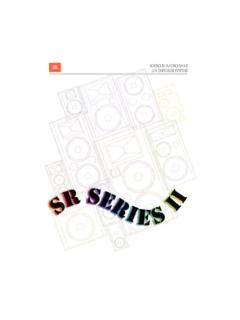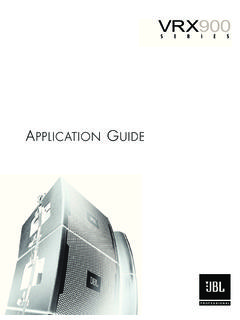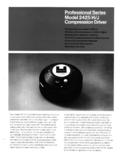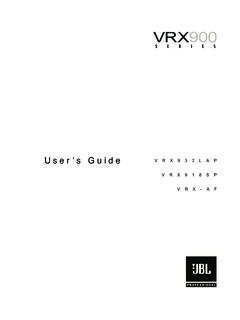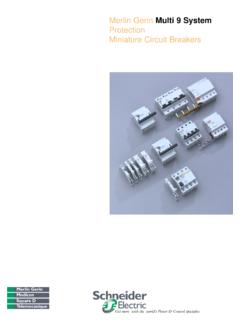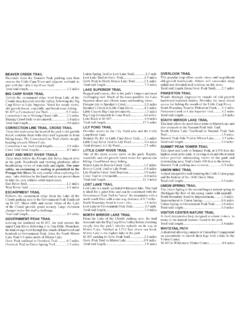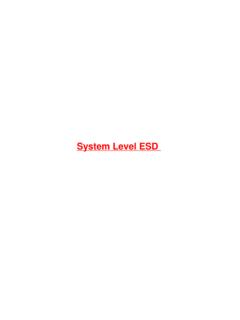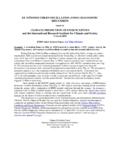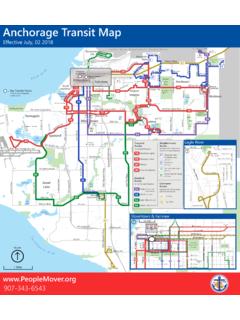Transcription of Sound System Design Reference Manual - JBL Professional
1 Sound System Design Reference Manual Sound System Design Reference Manual Sound System Design Reference Manual Table of Contents Preface .. i Chapter 1: Wave Propagation .. 1-1. Wavelength, Frequency, and Speed of Sound .. 1-1. Combining Sine Waves .. 1-2. Combining Delayed Sine Waves .. 1-3. Diffraction of Sound .. 1-5. Effects of Temperature Gradients on Sound Propagation .. 1-6. Effects of Wind Velocity and Gradients on Sound Propagation .. 1-6. Effect of Humidity on Sound Propagation .. 1-7. Chapter 2: The Decibel .. 2-1. Introduction .. 2-1. Power Relationships .. 2-1. Voltage, Current, and Pressure Relationships .. 2-2.
2 Sound Pressure and Loudness Contours .. 2-4. Inverse Square Relationships .. 2-6. Adding Power Levels in dB .. 2-7. Reference Levels .. 2-7. Peak, Average, and RMS Signal Values .. 2-8. Chapter 3: Directivity and Angular Coverage of Loudspeakers .. 3-1. Introduction .. 3-1. Some Fundamentals .. 3-1. A Comparison of Polar Plots, Beamwidth Plots, Directivity Plots, and Isobars .. 3-3. Directivity of Circular Radiators .. 3-4. The Importance of Flat Power Response .. 3-6. Measurement of Directional Characteristics .. 3-7. Using Directivity Information .. 3-8. Directional Characteristics of Combined Radiators .. 3-8. Chapter 4: An Outdoor Sound Reinforcement System .
3 4-1. Introduction .. 4-1. The Concept of Acoustical Gain .. 4-2. The Influence of Directional Microphones and Loudspeakers on System Maximum Gain .. 4-3. How Much Gain is Needed? .. 4-4. Conclusion .. 4-5. Chapter 5: Fundamentals of Room Acoustics .. 5-1. Introduction .. 5-1. Absorption and Reflection of Sound .. 5-1. The Growth and Decay of a Sound Field in a Room .. 5-5. Reverberation and Reverberation Time .. 5-7. Direct and Reverberant Sound Fields .. 5-12. Critical Distance .. 5-14. The Room Constant .. 5-15. Statistical Models and the Real World .. 5-20. Sound System Design Reference Manual Table of Contents (cont.).
4 Chapter 6: Behavior of Sound Systems Indoors .. 6-1. Introduction .. 6-1. Acoustical Feedback and Potential System Gain .. 6-2. Sound Field Calculations for a Small Room .. 6-2. Calculations for a Medium-Size Room .. 6-5. Calculations for a Distributed Loudspeaker System .. 6-8. System Gain vs. Frequency Response .. 6-9. The Indoor Gain Equation .. 6-9. Measuring Sound System Gain .. 6-10. General Requirements for Speech Intelligibility .. 6-11. The Role of Time Delay in Sound Reinforcement .. 6-16. System Equalization and Power Response of Loudspeakers .. 6-17. System Design Overview .. 6-19. Chapter 7: System Architecture and Layout.
5 7-1. Introduction .. 7-1. Typical Signal Flow Diagram .. 7-1. Amplifier and Loudspeaker Power Ratings .. 7-5. Wire Gauges and Line Losses .. 7-5. Constant Voltage Distribution Systems (70-volt lines) .. 7-6. Low Frequency Augmentation Subwoofers .. 7-6. Case Study A: A Speech and Music System for a Large Evangelical Church .. 7-9. Case Study B: A Distributed Sound Reinforcement System for a Large Liturgical Church .. 7-12. Case Study C: Specifications for a Distributed Sound System Comprising a Ballroom, Small Meeting Space, and Social/Bar Area .. 7-16. Bibliography Sound System Design Reference Manual Preface to the 1999 Edition: This third edition of JBL Professional 's Sound System Design Reference Manual is presented in a new graphic format that makes for easier reading and study.
6 Like its predecessors, it presents in virtually their original 1977 form George Augspurger's intuitive and illuminating explanations of Sound and Sound System behavior in enclosed spaces. The section on systems and case studies has been expanded, and references to JBL components have been updated. The fundamentals of acoustics and Sound System Design do not change, but System implementation improves in its effectiveness with ongoing developments in signal processing, transducer refinement, and front-end flexibility in signal routing and control. As stated in the Preface to the 1986 edition: The technical competence of Professional dealers and Sound contractors is much higher today than it was when the Sound Workshop Manual was originally introduced.
7 It is JBL's feeling that the serious contractor or Professional dealer of today is ready to move away from simply plugging numbers into equations. Instead, the designer is eager to learn what the equations really mean, and is intent on learning how loudspeakers and rooms interact, however complex that may be. It is for the student with such an outlook that this Manual is intended. John Eargle January 1999. i Sound System Design Reference Manual Sound System Design Reference Manual Chapter 1: Wave Propagation Wavelength, Frequency, and Speed of Period (T) is defined as the time required for Sound one cycle of the waveform. T = 1/f.
8 Sound waves travel approximately 344 m/sec For f = 1 kHz, T = 1/1000, or sec, and (1130 ft/sec) in air. There is a relatively small velocity l = 344/1000, or .344 m ( ft.). dependence on temperature, and under normal indoor conditions we can ignore it. Audible Sound The lowest audible sounds have wavelengths covers the frequency range from about 20 Hz to 20 on the order of 10 m (30 ft), and the highest sounds kHz. The wavelength of Sound of a given frequency have wavelengths as short as 20 mm ( in). The is the distance between successive repetitions of the range is quite large, and, as we will see, it has great waveform as the Sound travels through air.
9 It is given bearing on the behavior of Sound . by the following equation: The waves we have been discussing are of course sine waves, those basic building blocks of all wavelength = speed/frequency speech and music signals. Figure 1-1 shows some of the basic aspects of sine waves. Note that waves of or, using the common abbreviations of c for speed, the same frequency can differ in both amplitude and f for frequency, and l for wavelength: in phase angle. The amplitude and phase angle relationships between sine waves determine how l = c/f they combine, either acoustically or electrically. Figure 1-1. Properties of sine waves 1-1.
10 Sound System Design Reference Manual Combining Sine Waves replica of the input signal, except for its amplitude. The two signals, although not identical, are said to Referring to Figure 1-2, if two or more sine be highly coherent. If the signal is passed through a wave signals having the same frequency and poor amplifier, we can expect substantial differences amplitude are added, we find that the resulting signal between input and output, and coherence will not be also has the same frequency and that its amplitude as great. If we compare totally different signals, any depends upon the phase relationship of the original similarities occur purely at random, and the two are signals.
